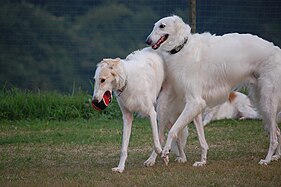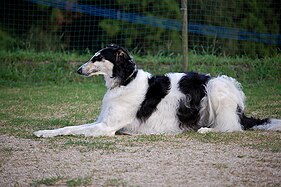The Borzoi[a] or Russian Hunting Sighthound[b] is a Russian breed of hunting dog of sighthound type. It was formerly used for wolf hunting,[1]: 125 and until 1936 was known as the Russian Wolfhound.[1]: 130 [3]
| Borzoi | |||||||||||||||||||||||||||||||
|---|---|---|---|---|---|---|---|---|---|---|---|---|---|---|---|---|---|---|---|---|---|---|---|---|---|---|---|---|---|---|---|
 | |||||||||||||||||||||||||||||||
| Other names |
| ||||||||||||||||||||||||||||||
| Origin | Russia | ||||||||||||||||||||||||||||||
| |||||||||||||||||||||||||||||||
| |||||||||||||||||||||||||||||||
| Dog (domestic dog) | |||||||||||||||||||||||||||||||
Etymology
editThe system by which Russians over the ages named their sighthounds was a series of descriptive terms rather than actual names. Borzoi is the masculine singular form of an archaic Russian adjective that means 'fast'. Borzaya sobaka ('fast dog') is the basic term for sighthounds used by Russians, though sobaka is usually dropped. The name psovaya derived from the word psovina, which means 'wavy, silky coat', just as hortaya (as in hortaya borzaya) means shorthaired. In modern Russian, the breed commonly called the Borzoi is officially known as russkaya psovaya borzaya. Other Russian sighthound breeds are stepnaya borzaya (from the steppe), called stepnoi; and krimskaya borzaya (from the Crimea), called krimskoi.[4][failed verification]
History
editThe Borzoi originated in the sixteenth century Russia by crossing Saluki and European sighthounds with thick-coated Russian breeds.[5][6]
The Borzoi was popular with the Tsars before the 1917 revolution. For centuries, Borzois could not be purchased but only given as gifts from the Tsar. Grand Duke Nicholas Nicolaievich of Russia bred countless Borzoi at Perchino, his private estate.[7]: 10 [8]
Because of their association with the aristocracy, Borzoi were killed en masse by communist forces during the Russian Revolution, leading to their rarity as a modern dog breed.[9]
The Russkaya Psovaya Borzaya was definitively accepted by the Fédération Cynologique Internationale in 1956.[10]
- Borzoi owned by Max Hartenstein, Berlin, Germany, 1879
- "Borzo by a Chair" (St George Hare, 19th century)
- Wolf hunting with borzois (1904), Efim A. Tikhmenev
- Sarah Bernhardt, portrait by Georges Clairin
Description
editAppearance
editBorzois are large Russian sighthounds that resemble some central Asian breeds such as the Afghan hound, Saluki, and the Kyrgyz Taigan. Borzois come in a variety of colours.[11] The Borzoi coat is silky and flat, often wavy or slightly curly. The long top-coat is quite flat, with varying degrees of waviness or curling. The soft undercoat thickens during winter or in cold climates, but is shed in hot weather to prevent overheating. In its texture and distribution over the body, the Borzoi coat is unique. There should be a frill on its neck, as well as feathering on its hindquarters and tail.[12][13]
Temperament
editThe Borzoi is an affectionate and athletic breed of dog with a calm temperament.[14]
In terms of obedience, Borzois are selective learners who quickly become bored with repetitive, apparently pointless activity, and they can be very stubborn when they are not properly motivated. For example, food rewards, or "baiting", may work well for some individuals, but not at all for others. Nevertheless, Borzois are definitely capable of enjoying and performing well in competitive obedience and agility trials with the right kind of training.[7]: 113 [15][16]
Health
editA 2024 UK study found a life expectancy of 12 years for the breed with a sample size of 43, compared to an average of 12.7 for purebreeds and 12 for crossbreeds.[17]
An American study looking at echocardiographs of clinically healthy Borzoi found 53.8% to have heart murmurs, 30.2% to have trace or mild mitral regurgitation, 36.1% to have mild tricuspid regurgitation, and 14.4% to have cardiac disease.[18]
- Coat colours
- Red
- Black
- White and yellow-and-white
- Red and white
- Black and white
- White and brown
- White and grey
- White and sandy
Notes
editReferences
edit
Further reading
edit- Chadwick, Winifred E. (1952). The Borzoi Handbook. London: Nicholson & Watson. Including a translation of The Perchino Hunt by His Excellency Dmitri Walzoff (1912).
- Martin, Nellie L. (2005). Borzoi—The Russian Wolfhound: Its History, Breeding, Exhibiting and Care. Read Books. ISBN 978-1-84664-042-1.
- McRae, Gail C. (1989). Borzoi (New ed.). TFH Publications. ISBN 978-0-86622-676-9.
- Savenkova, V. (2003). Russkaya Psovaya Borzaya. Moscow. ISBN 978-5170169740.











